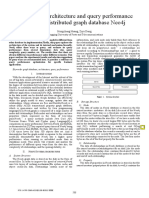0% found this document useful (0 votes)
20 views4 pagesNeo4j Practical Implementation
The document outlines the practical implementation of an Online Course Management System using Neo4j, detailing the creation of nodes for Students, Courses, and Professors, along with their relationships. It covers CRUD operations, the use of Neo4j clauses like MERGE, WRITE, and READ, and demonstrates string and mathematical functions. Additionally, it explains the creation of user-defined functions to enhance Neo4j's capabilities.
Uploaded by
shetyebhakti07Copyright
© © All Rights Reserved
We take content rights seriously. If you suspect this is your content, claim it here.
Available Formats
Download as DOCX, PDF, TXT or read online on Scribd
0% found this document useful (0 votes)
20 views4 pagesNeo4j Practical Implementation
The document outlines the practical implementation of an Online Course Management System using Neo4j, detailing the creation of nodes for Students, Courses, and Professors, along with their relationships. It covers CRUD operations, the use of Neo4j clauses like MERGE, WRITE, and READ, and demonstrates string and mathematical functions. Additionally, it explains the creation of user-defined functions to enhance Neo4j's capabilities.
Uploaded by
shetyebhakti07Copyright
© © All Rights Reserved
We take content rights seriously. If you suspect this is your content, claim it here.
Available Formats
Download as DOCX, PDF, TXT or read online on Scribd
/ 4






















































































